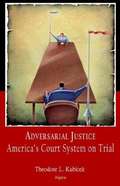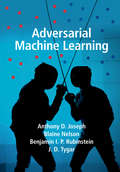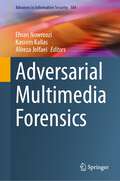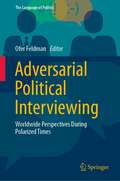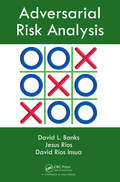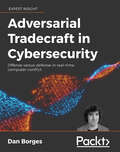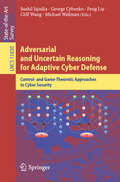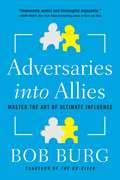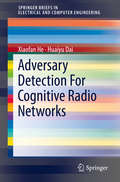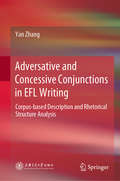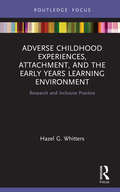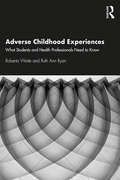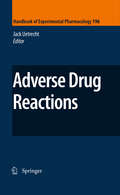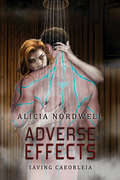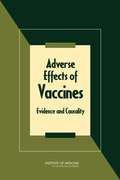- Table View
- List View
Adversarial Justice: America's Court System on Trial
by Theodore L. KubicekOh, those lawyers! <P><P>The legal profession in fact, the legal system certainly has a poor reputation in the United States. Proposed remedies, however, rarely go as deep as the ethics of the system. America's judicial system should not be a game that anyone can win, regardless of actual guilt or liability. Ted Kubicek, JD, describes the problems and proposes solutions. Above all, he condemns the adversary system of justice which is used to evade the truth and which makes winning the paramount goal. <P><P>Dr. Kubicek postulates that the attorney-client privilege of communication makes the truth more difficult, even impossible, to determine. The adversary system goes hand in hand with the privilege of communication since neither can exist without the other. <P><P>He advocates moving instead to an inquisitorial system, in which truth is the goal of both parties, not just of the party that would gain thereby. He then shows how the elimination of adversaryism would automatically remedy other problems endemic to the system of justice, too, such as the passiveness of trial judges and juries. <P><P>Scrapping the adversary system would abolish trial and pretrial procedures and evidentiary rules that confuse law enforcement and trial participants alike. Criminal verdicts would not then depend upon confusing evidentiary or technical matters having no connection to the guilt or innocence of the accused. <P><P>This book is intended to encourage the legal profession, the judiciary, and the organized bar to remedy America's counter-productive judicial procedures. The argument will also interest anyone who has ever had to go to trial.
Adversarial Legalism: The American Way of Law, Second Edition (California Series In Law, Politics, And Society Ser. #1)
by Robert A. KaganAmerican dispute resolution is more adversarial, compared with systems of other economically advanced countries. Americans more often rely on legal threats and lawsuits. American laws are generally more complicated and prescriptive, adjudication more costly, penalties more severe. Here, Kagan examines the origins and consequences of this system.
Adversarial Machine Learning
by Anthony D. Joseph Blaine Nelson Benjamin I. Rubinstein J. D. TygarWritten by leading researchers, this complete introduction brings together all the theory and tools needed for building robust machine learning in adversarial environments. Discover how machine learning systems can adapt when an adversary actively poisons data to manipulate statistical inference, learn the latest practical techniques for investigating system security and performing robust data analysis, and gain insight into new approaches for designing effective countermeasures against the latest wave of cyber-attacks. Privacy-preserving mechanisms and the near-optimal evasion of classifiers are discussed in detail, and in-depth case studies on email spam and network security highlight successful attacks on traditional machine learning algorithms. Providing a thorough overview of the current state of the art in the field, and possible future directions, this groundbreaking work is essential reading for researchers, practitioners and students in computer security and machine learning, and those wanting to learn about the next stage of the cybersecurity arms race.
Adversarial Multimedia Forensics (Advances in Information Security #104)
by Kassem Kallas Ehsan Nowroozi Alireza JolfaeiThis book explores various aspects of digital forensics, security and machine learning, while offering valuable insights into the ever-evolving landscape of multimedia forensics and data security. This book’s content can be summarized in two main areas. The first area of this book primarily addresses techniques and methodologies related to digital image forensics. It discusses advanced techniques for image manipulation detection, including the use of deep learning architectures to generate and manipulate synthetic satellite images. This book also explores methods for face recognition under adverse conditions and the importance of forensics in criminal investigations. Additionally, the book highlights anti-forensic measures applied to photos and videos, focusing on their effectiveness and trade-offs.The second area of this book focuses on the broader landscape of security, including the detection of synthetic human voices, secure deep neural networks (DNNs) and federated learning in the context of machine learning security. It investigates novel methods for detecting synthetic human voices using neural vocoder artifacts, and it explores the vulnerabilities and security challenges of federated learning in the face of adversarial attacks. Furthermore, this book delves into the realms of linguistic steganography and steganalysis, discussing the evolving techniques that utilize deep learning and natural language processing to enhance payload and detection accuracy.Overall, this book provides a comprehensive overview of the ever-evolving field of digital forensics and security, making it an invaluable resource for researchers and students interested in image forensics, machine learning security and information protection. It equips readers with the latest knowledge and tools to address the complex challenges posed by the digital landscape. Professionals working in this related field will also find this book to be a valuable resource.
Adversarial Political Interviewing: Worldwide Perspectives During Polarized Times (The Language of Politics)
by Ofer FeldmanThis book presents a collection of studies on political interviews in a variety of broadcast media worldwide. Following the growing scholarly interest in media talk as a dominant form of political communication in contemporary society, a number of eminent international scholars analyze empirical material from the discourse of public figures and interviewer–journalists to address questions related to the characteristics, conduct, and potential effects of political interviews. Chapters span a varied array of cultural contexts: the U.S.A., U.K., Israel, Japan, Italy, Turkey, Greece, Australia, Philippines, Finland, Brazil, Malaysia, Spain, Venezuela, Montenegro, and the European Community, enabling a comparison of the different structures and contents of political interviews in societies from West to East. Authors bring an interest in discourse and conversation analysis, as well as in rhetorical techniques and strategies used by both interviewers and interviewees, from different disciplinary viewpoints including linguistic, political, cultural, sociological, and social–psychological. In doing so, the book develops a framework to assess the extent to which media political interviews and talk shows, and regular news programs, play a central role in transmitting accurate and genuine political information to the general public, and how audiences can make sense of these programs’ output.
Adversarial Reasoning: Computational Approaches to Reading the Opponent's Mind (Chapman & Hall/CRC Computer and Information Science Series)
by Alexander Kott William M. McEneaneyThe rising tide of threats, from financial cybercrime to asymmetric military conflicts, demands greater sophistication in tools and techniques of law enforcement, commercial and domestic security professionals, and terrorism prevention. Concentrating on computational solutions to determine or anticipate an adversary's intent, Adversarial Reasoning:
Adversarial Risk Analysis
by David L. Banks Jesus M. Aliaga David Rios InsuaWinner of the 2017 De Groot Prize awarded by the International Society for Bayesian Analysis (ISBA)A relatively new area of research, adversarial risk analysis (ARA) informs decision making when there are intelligent opponents and uncertain outcomes. Adversarial Risk Analysis develops methods for allocating defensive or offensive resources against
Adversarial Tradecraft in Cybersecurity: Offense versus defense in real-time computer conflict
by Dan BorgesMaster cutting-edge techniques and countermeasures to protect your organization from live hackers. Learn how to harness cyber deception in your operations to gain an edge over the competition.Key FeaturesGain an advantage against live hackers in a competition or real computing environmentUnderstand advanced red team and blue team techniques with code examplesLearn to battle in short-term memory, whether remaining unseen (red teams) or monitoring an attacker's traffic (blue teams)Book DescriptionLittle has been written about what to do when live hackers are on your system and running amok. Even experienced hackers tend to choke up when they realize the network defender has caught them and is zoning in on their implants in real time. This book will provide tips and tricks all along the kill chain of an attack, showing where hackers can have the upper hand in a live conflict and how defenders can outsmart them in this adversarial game of computer cat and mouse. This book contains two subsections in each chapter, specifically focusing on the offensive and defensive teams. It begins by introducing you to adversarial operations and principles of computer conflict where you will explore the core principles of deception, humanity, economy, and more about human-on-human conflicts. Additionally, you will understand everything from planning to setting up infrastructure and tooling that both sides should have in place.Throughout this book, you will learn how to gain an advantage over opponents by disappearing from what they can detect. You will further understand how to blend in, uncover other actors' motivations and means, and learn to tamper with them to hinder their ability to detect your presence. Finally, you will learn how to gain an advantage through advanced research and thoughtfully concluding an operation.By the end of this book, you will have achieved a solid understanding of cyberattacks from both an attacker's and a defender's perspective.What you will learnUnderstand how to implement process injection and how to detect itTurn the tables on the offense with active defenseDisappear on the defender's system, by tampering with defensive sensorsUpskill in using deception with your backdoors and countermeasures including honeypotsKick someone else from a computer you are on and gain the upper handAdopt a language agnostic approach to become familiar with techniques that can be applied to both the red and blue teamsPrepare yourself for real-time cybersecurity conflict by using some of the best techniques currently in the industryWho this book is forPentesters to red teamers, security operations center analysts to incident responders, attackers, defenders, general hackers, advanced computer users, and security engineers will benefit from this book. Participants in purple teaming or adversarial simulations will also learn a lot from its practical examples of processes for gaining an advantage over the opposing team.Basic knowledge of Python, Go, Bash, PowerShell, system administration as well as knowledge of incident response in Linux and prior exposure to any kind of cybersecurity knowledge, penetration testing, and ethical hacking basics will help you follow along.
Adversarial and Uncertain Reasoning for Adaptive Cyber Defense: Control- and Game-Theoretic Approaches to Cyber Security (Lecture Notes in Computer Science #11830)
by Sushil Jajodia Cliff Wang Peng Liu George Cybenko Michael WellmanToday’s cyber defenses are largely static allowing adversaries to pre-plan their attacks. In response to this situation, researchers have started to investigate various methods that make networked information systems less homogeneous and less predictable by engineering systems that have homogeneous functionalities but randomized manifestations. The 10 papers included in this State-of-the Art Survey present recent advances made by a large team of researchers working on the same US Department of Defense Multidisciplinary University Research Initiative (MURI) project during 2013-2019. This project has developed a new class of technologies called Adaptive Cyber Defense (ACD) by building on two active but heretofore separate research areas: Adaptation Techniques (AT) and Adversarial Reasoning (AR). AT methods introduce diversity and uncertainty into networks, applications, and hosts. AR combines machine learning, behavioral science, operations research, control theory, and game theory to address the goal of computing effective strategies in dynamic, adversarial environments.
Adversaries into Allies
by Bob BurgThe Sages asked, "Who is mighty?" and answered, "Those who can control their own emotions and make of an enemy a friend. " In the bestselling book The Go-Giver, Bob Burg and John David Mann revolutionized the way we think about success via one very simple lesson: "Shifting one's focus from getting to giving (constantly and consistently providing value to others) is both very fulfilling and the most profitable way to do business. Now Burg is back with a new book, offering deeper insight into what it means to be truly influential and providing powerful strategies for mastering the art of winning people over. Faced with the task of persuading someone to do what we want, most of us expect, and often encounter, resistance. We see the other person as an adversary and often resort to coercion or manipulation in order to get our way. But while this approach might at times bring us short-term results, it leaves people with a bad feeling about themselves and about us. At that point, our relationship with the person is weakened and our influence dramatically decreased. There is a better way. Drawing on his own experiences and the stories of other influential people, Burg offers five simple principles of what he calls Ultimate Influence-the ability to win people to your side in a way that leaves everyone feeling great about the outcome . . . and about themselves!: Control your own emotions: Responding calmly rather than allowing your emotions to get the better of you will ensure not putting others on the defensive but rather help them remain open to your ideas. Understand the clash of belief systems: Every individual operates based on an unconscious set of beliefs, experiences, and ideas, which are most likely very different from yours. Understand this and you can avoid confusion and numerous misunderstandings that stand in the way of most people's ability to influence. Acknowledge their ego: People want to feel good about themselves; if you make someone genuinely feel good, you're one step closer to making an ally. Set the proper frame: People react and respond to other people. Approach potential conflicts from a position of benevolence, resolution, and helpfulness and they will follow suit. Communicate with tact and empathy: While the first four principles are vital, this is what brings it all home. Saying the right thing at the right time makes all the difference in terms of moving people to your side of the issue and taking the appropriate action that benefits all concerned. In the tradition of Dale Carnegie's How to Win Friends and Influence People and Robert Cialdini's Influence, Burg offers a tried-and-true framework for building alliances at work, at home, and anywhere else you seek to win people over. .
Adversary Detection For Cognitive Radio Networks (Springerbriefs In Electrical And Computer Engineering)
by Xiaofan He Huaiyu DaiThis SpringerBrief provides a comprehensive study of the unique security threats to cognitive radio (CR) networks and a systematic investigation of the state-of-the-art in the corresponding adversary detection problems. In addition, detailed discussions of the underlying fundamental analytical tools and engineering methodologies of these adversary detection techniques are provided, considering that many of them are quite general and have been widely employed in many other related fields.
Adversary Emulation with MITRE ATT&CK
by Drinor SelmanajBy incorporating cyber threat intelligence, adversary emulation provides a form of cybersecurity assessment that mimics advanced persistent threat (APT) tactics, techniques, and procedures (TTPs). This comprehensive guide introduces an empirical approach with strategies and processes collected over a decade of experience in the cybersecurity field. You'll learn to assess resilience against coordinated and stealthy threat actors capable of harming an organization.Author Drinor Selmanaj demonstrates adversary emulation for offensive operators and defenders using practical examples and exercises that actively model adversary behavior. Each emulation plan includes different hands-on scenarios, such as smash-and-grab or slow-and-deliberate. This book uses the MITRE ATT&CK knowledge base as a foundation to describe and categorize TTPs based on real-world observations, and provides a common language that's standardized and accessible to everyone.You'll learn how to:Map Cyber Threat Intelligence to ATT&CKDefine Adversary Emulation goals and objectivesResearch Adversary Emulation TTPs using ATT&CK knowledge basePlan Adversary Emulation activityImplement Adversary tradecraftConduct Adversary EmulationCommunicate Adversary Emulation findingsAutomate Adversary Emulation to support repeatable testingExecute FIN6, APT3, and APT29 emulation plans
Adversary-Aware Learning Techniques and Trends in Cybersecurity
by Ranjeev Mittu Prithviraj Dasgupta Joseph B. CollinsThis book is intended to give researchers and practitioners in the cross-cutting fields of artificial intelligence, machine learning (AI/ML) and cyber security up-to-date and in-depth knowledge of recent techniques for improving the vulnerabilities of AI/ML systems against attacks from malicious adversaries. The ten chapters in this book, written by eminent researchers in AI/ML and cyber-security, span diverse, yet inter-related topics including game playing AI and game theory as defenses against attacks on AI/ML systems, methods for effectively addressing vulnerabilities of AI/ML operating in large, distributed environments like Internet of Things (IoT) with diverse data modalities, and, techniques to enable AI/ML systems to intelligently interact with humans that could be malicious adversaries and/or benign teammates. Readers of this book will be equipped with definitive information on recent developments suitable for countering adversarial threats in AI/ML systems towards making them operate in a safe, reliable and seamless manner.
Adversative and Concessive Conjunctions in EFL Writing: Corpus-based Description and Rhetorical Structure Analysis
by Yan ZhangThis book explores the usage patterns of a group of adversative and concessive conjunctions in English texts written by Chinese EFL learners and their native speaker counterparts. Focusing on probability profiles and systemic potentials, the study encompasses three stages and combines the strengths of two research methods – the corpus-based approach and text-based analysis – to examine the conjunctions under the theoretical framework of systemic functional linguistics and rhetorical structure theory. Starting with an overview of seventeen conjunctions across two corpora in terms of overall frequency, positional distribution and distribution of semantic categories, the book then offers a more detailed discussion of three individual conjunctions, highlighting the interconnections between 1) syntactic positions and co-occurrence patterns and 2) semantic relations encoded by these conjunctions. Lastly, it presents a case study of one full-length text taken from the learner corpus, applying rhetorical structure theory to provide new insights into the relevance of adversative and concessive relations to text structure. This comprehensive, in-depth analysis is both diagnostic and pedagogically informative.
Adverse Childhood Experiences and Serious Youth Violence
by Paul Gray Deborah Jump Hannah SmithsonWhereas crime more generally has fallen over the last 20 years, levels of serious youth violence remain high. This book presents innovative research into the complex relationship between adverse childhood experiences and serious youth violence. While the implementation of trauma-informed approaches to working with adolescents in the justice system is becoming common practice, there remains a dearth of research into the efficacy of such approaches. Foregrounding young people’s voices, this book explores the theoretical underpinnings of trauma and the manifestations of childhood adversity. The authors conclude by advocating for a more psychosocial approach to trauma-informed policy and practice within the youth justice system.
Adverse Childhood Experiences, Attachment, and the Early Years Learning Environment: Research and Inclusive Practice
by Hazel G. WhittersAdverse Childhood Experiences, Attachment, and the Early Years Learning Environment explores the concept of learning by presenting research and illustrations from practice on three major topics: adverse childhood experiences, attachment, and environment. Each child has a unique reaction to adversity in the early years, and the book discusses the effect upon approach and avoidance motivation for learning, and the rationale of trauma-informed practice. The influence from a secure attachment figure is explored, and links between emotions and involvement are presented. The book highlights the current indoor and outdoor use of natural green spaces as a response to attention-fatigue and promotes comprehension of the issues in a context of attention restoration theory. Intervention for extended families is presented as an approach to supporting development and attainment in each generation, and to achieving a legacy beyond the professional network. This book will appeal to academics, researchers, and postgraduate students in the fields of early years care and education. It will also appeal to those working within children’s services.
Adverse Childhood Experiences: The Neuroscience of Trauma, Resilience and Healing throughout the Life Course
by Kathleen Brewer-SmythThe entire world is in crisis with adverse childhood experiences (ACEs) and other lifetime trauma at an all-time high. This book is a valuable resource to promote optimal brain function for everyone, but especially for survivors of trauma who are particularly at risk throughout the life course. It is critical for healthcare providers, schoolteachers and administration, public safety professionals, foster and adoptive parents, employers and loved ones to understand the potential life-long consequences that ACEs can have in the lives of survivors. This book describes the complexities behind why behaviors occur if hurt people hurt themselves and others. The first half of this book addresses what can go wrong in the brain and body after trauma that potentially leads to life-long poor bio-behavioral health outcomes. The second half of this book addresses how the life-long poor bio-behavioral health outcomes can be prevented, mitigated or potentially reversed. This book is necessary for everyone who is interested in optimizing brain function, especially survivors of ACEs and other trauma throughout the life course who are at greater risk. The major focus of the book is on how to prevent long-term negative consequences of trauma and how to restore the brain, body, behavior and emotions.
Adverse Childhood Experiences: What Students and Health Professionals Need to Know
by Roberta Waite Ruth Ann RyanThis guide provides healthcare students and professionals with a foundational background on adverse childhood experiences (ACEs) – traumatic early life experiences, which can have a profound impact on health in later life. ACEs can include being a victim of abuse, neglect or exposure to risk in the home or community. How healthcare students and professionals learn to recognize, react and respond to persons affected by trauma will lay the foundation for their relationships with patients. This book intentionally uses micro-to-macro lenses accompanied by a structural competency framework to elucidate health implications across the lifespan. It explores the nature of adversity and its effects on the physical, emotional, cognitive and social health of individuals, communities and society. The book, written by two experienced psychiatric nurses, will equip healthcare students and professionals with an understanding for critical change in practice and offer action steps designed to assist them with prevention and intervention approaches and steps to help build resilience. This book will be core reading for healthcare students within mental health, pediatric and primary care nursing courses. It will also be of interest to students and professionals in the social work, psychology and public health fields who are exploring resilience and trauma-informed practices
Adverse Cutaneous Drug Reactions to Cardiovascular Drugs
by Esen Özkaya Kurtuluş Didem YazganoğluAdverse cutaneous drug reactions (ACDR) are among the most frequent events in patients receiving drug therapy. Cardiovascular (CV) drugs are an important group of drugs with potential risk of developing ACDR especially in elderly as marketing of more new drugs and their prescription continue to increase. However, like with most other drugs the exact incidence of cutaneous side effects from CV drugs is difficult to estimate due to sporadic reporting. Moreover, a reliable designation of a certain drug as the cause of a certain type of reaction can rarely be made. Apart from the well-known angioedema/urticaria from ACE inhibitors, lichen planus / lichenoid reaction from beta adrenergic blockers and photosensitivity from thiazid diuretics, ACDR from CV drugs might be seen in a wide spectrum extending to rare but life-threatening conditions such as erythroderma, Stevens-Johnson syndrome, toxic epidermal necrolysis or drug hypersensitivity syndrome. In this comprehensive review, the reported types of ACDR to CV drugs will be discussed according to drug class and the type of dermatologic reaction with special emphasize on cross-reactions and the role of patch testing in diagnosis.
Adverse Drug Event Reporting: The Roles Of Consumers And Health-care Professionals
by Institute of Medicine of the National AcademiesThe National Academies Press (NAP)--publisher for the National Academies--publishes more than 200 books a year offering the most authoritative views, definitive information, and groundbreaking recommendations on a wide range of topics in science, engineering, and health. Our books are unique in that they are authored by the nation's leading experts in every scientific field.
Adverse Drug Interactions: A Handbook for Prescribers, Second Edition
by Simon Clarke Ursula Gotel nee Collignon Janaka Karalliedde Lakshman KarallieddeAdverse Drug Interactions: A Handbook for Prescribers assists clinicians by providing key information on potential adverse effects that can result from prescribing two or more drugs for simultaneous use. Interactions that are likely to give rise to life-threatening conditions, and which must therefore be completely avoided, are clearly highlighted.
Adverse Drug Reactions (Handbook of Experimental Pharmacology #196)
by Jack UetrechtThis book provides the current state of knowledge of basic mechanisms of adverse drug reactions (ADRs). The main focus is on idiosyncratic drug reactions because they are the most difficult to deal with. It starts with a general description of the major targets for ADRs followed by a description of what are presently believed to be mediators and biochemical pathways involved in idiosyncratic drug reactions. There is also a description of several examples of ADRs that serve to illustrate specific aspects of ADR mechanisms. Eventually the book shows that ultimately better methods are needed to predict which drug candidates are likely to cause ADRs and which patients are at increased risk. But at present research seems to be far from this goal.
Adverse Effects (Saving Caeorleia #2)
by Alicia NordwellSaving Caeorleia: Book TwoDade, human-Caeorleian hybrid and ex-military grunt, doesn't fit in--not with humans, not with aliens, not anywhere. He's always on the outskirts, angry, and people aren't sure they can trust him. When he encounters a compatible tziu named Yaseke, secrets, misunderstandings, and attacks nearly prevent the two from making a connection Dade sorely needs. Even after they unite, Dade and Yaseke face challenges that two newly joined males should never have to endure. From traitorous council members, to sadistic aliens who plan to sell them as slaves, to meeting a mysterious race of revered aliens called Collectors, Dade and Yaseke manage to stay together--and even rescue two youths related to Yaseke, who've lost their parents to the same betrayer. Someone from Dade's past is at the root of everything he's suffered. No way can he let them get away with what they're planning, but Dade isn't sure he can stop them on his own. If he doesn't let go of his isolation and risk the pain letting others in will bring, he'll never save Caeorleia in time.
Adverse Effects of Vaccines
by Committee to Review Adverse Effects of VaccinesIn 1900, for every 1,000 babies born in the United States, 100 would die before their first birthday, often due to infectious diseases. Today, vaccines exist for many viral and bacterial diseases. The National Childhood Vaccine Injury Act, passed in 1986, was intended to bolster vaccine research and development through the federal coordination of vaccine initiatives and to provide relief to vaccine manufacturers facing financial burdens. The legislation also intended to address concerns about the safety of vaccines by instituting a compensation program, setting up a passive surveillance system for vaccine adverse events, and by providing information to consumers. A key component of the legislation required the U. S. Department of Health and Human Services to collaborate with the Institute of Medicine to assess concerns about the safety of vaccines and potential adverse events, especially in children. Adverse Effects of Vaccines reviews the epidemiological, clinical, and biological evidence regarding adverse health events associated with specific vaccines covered by the National Vaccine Injury Compensation Program (VICP), including the varicella zoster vaccine, influenza vaccines, the hepatitis B vaccine, and the human papillomavirus vaccine, among others. For each possible adverse event, the report reviews peer-reviewed primary studies, summarizes their findings, and evaluates the epidemiological, clinical, and biological evidence. It finds that while no vaccine is 100 percent safe, very few adverse events are shown to be caused by vaccines. In addition, the evidence shows that vaccines do not cause several conditions. For example, the MMR vaccine is not associated with autism or childhood diabetes. Also, the DTaP vaccine is not associated with diabetes and the influenza vaccine given as a shot does not exacerbate asthma. Adverse Effects of Vaccines will be of special interest to the National Vaccine Program Office, the VICP, the Centers for Disease Control and Prevention, vaccine safety researchers and manufacturers, parents, caregivers, and health professionals in the private and public sectors.
Adverse Events with Biomedicines: Prevention Through Understanding
by Giuseppe TridenteThis monograph gathers and evaluates data on adverse events (AEs) associated specifically with those "biomedicines" - monoclonal antibodies, fusion proteins, and cytokines - that have recently entered therapeutic use in humans. All AEs observed when using each member of this new drug class are covered, with a view to improving understanding of pathogenesis, facilitating prevention, monitoring, and control, and contributing to the development of better drugs that provide benefits while minimizing risk. Further aspects here examined include the role of drug mechanisms of action and immunogenicity in relation to AEs outcome and induction of systemic syndromes. Additional data on AEs in off-label treatments are also considered. Electronic data sheets, downloadable from Springer Extra Materials platform, include more detailed safety data as well as additional basic information on product characteristics, pre- and post-marketing AEs classified according to frequency, and system/organ targeting. Data on excipients and selected information on drug interactions and associations are also provided. Adverse Events with Biomedicines: Prevention Through Understanding will serve as a detailed, practical guideline to this important new area, which demands the attention of clinicians, immunologists, oncologists, allergologists, public health professionals, and drug companies.
